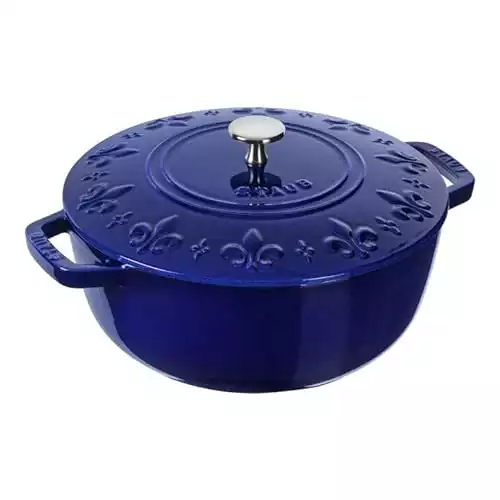If you’re ever confused with different types of cookware out there, you’re not alone. Just take a look at a random cookware company’s webpage, and you’ll be confused with different terms for cookware and materials they’re made from.
One of these confusing duos is the French oven vs. the Dutch oven. Are they different? Or, are these names just cultural terms or marketing tricks?
Is a French Oven the Same as a Dutch Oven?
A French oven is a type of Dutch oven. While a Dutch oven can be made of different materials, such as stainless steel and raw cast iron, a French oven is made of enameled cast iron. So, every French oven is a Dutch oven, but not the other way around.
What’s a Dutch Oven?
The Dutch oven was likely invented in the 18th century, but the origin of the name is not settled. One theory is that the Dutch learned how to pour melted metals into molds to make sturdy cooking vessels. Another is that Dutch traders, prolific at the time, spread the pots around the world.
Whatever its origin, a Dutch oven is a pot with a tight-fitting lid that makes it a great choice for low-and-slow cooking. It’s a versatile pot that you can use for just about any cooking method, from braising and baking to boiling and simmering.
The traditional Dutch oven is made of raw cast iron, but modern ones are available in other materials, such as stainless steel, nonstick, and ceramic.
Cast iron Dutch ovens are heavy and compatible with every stovetop. Plus, they are long-lasting, with the ability to become an heirloom and last for generations.
What’s a French Oven?
So, if a Dutch oven was made by the Dutch and came from the Netherlands, does the French oven originate in France? Well, not necessarily!
A French oven is basically a Dutch oven with enamel coating. French oven history isn’t as old as the Dutch oven’s, since it was first introduced in 1925 by Le Creuset.

The innovative company decided to take the traditional cast iron Dutch oven and give it a makeover. Using vibrant colors, Le Creuset gave Dutch ovens a new look that home chefs could proudly display in their kitchens.
They decided to call it the French oven to distinguish it from the traditional Dutch oven. But the name didn’t catch on; many people call it the enameled cast iron Dutch oven today.
Now, Le Creuset isn’t the only company that makes French ovens. Many other companies, including Staub, also make French ovens that are not as expensive as Le Creuset.
French Oven vs. Dutch Oven
So, we could say that French and Dutch ovens are the same, but made of different coating materials. These coating materials give them unique features, making them better options for different cooking scenarios.
Let’s look at the pros and cons of both.
French Oven Pros
French Oven Cons
Features the same excellent cooking characteristics as the Cocotte. This French oven retains heat beautifully, so your food stays hot. Perfect for dishes that need frequent stirring, its shape lets you reach every corner easily.
Dutch Oven Pros
Dutch Oven Cons
The “Essential Enamel” Lodge Dutch oven is affordable and a great introduction to cooking in enameled cast iron. It releases more steam when cooking and takes a bit longer to heat up, but it retains heat almost as well as higher-end models.
Conclusion
Dutch ovens and French ovens are very similar. Both are large and deep pots made of cast iron. The only difference is that Dutch ovens come in raw cast iron, stainless steel, ceramic, or nonstick materials. But French ovens are just cast iron vessels with enameled exteriors and interiors.
Do you have a French oven? Is it different from a regular Dutch oven regarding versatility and maintenance? Please share your thoughts below.











